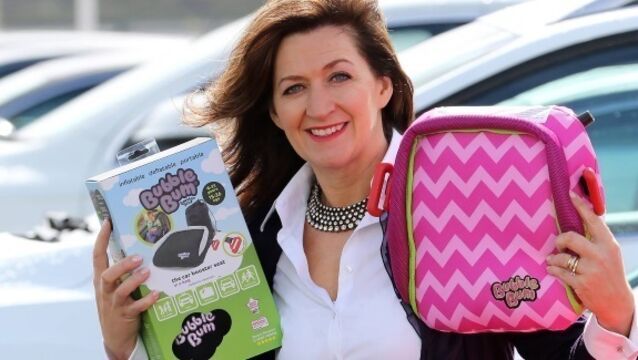Why Amazon-based seller BubbleBum turned to revenue-based finance
Baby & Toddler
United Kingdom
https://www.bubblebum.co/
No one needs to tell parents how much of a hassle it is to transfer a car seat from one vehicle to another — including Grainne Kelly. To avoid having to lug around a booster seat when vacationing, this travel agent and mom made it a habit to request a seat ahead of time when renting a car. But she kept running into the same problem: according to Grainne, the auto rental desks “never had the car seats” when she arrived.

This was more than just a recurring inconvenience. The missing booster seats presented a safety risk. And Grainne knew she couldn’t be the only parent facing this issue. So, she came up with the idea for an inflatable booster seat that would be easy to transport. As a result, she launched her eCommerce company, BubbleBum, in 2009.
Today, the company sells its innovative booster seats in 27 countries through its Amazon store, with plans to grow and expand in the near future.
Still, designing an easy-to-transport car seat and launching a new business wasn’t easy for Grainne, especially when a global pandemic halted travel and parents stopped shopping for BubbleBum’s product. It was only with fast access to flexible financing that BubbleBum was able to recover from the pandemic and grow the business.
This is BubbleBum’s success story.
BubbleBum started with a mission to make life easier for traveling parents
To appeal to the specific audience she had in mind, Grainne had to design a totally new product. She successfully pitched her innovative inflatable booster seat to a venture capital firm, which funded her prototype development.
If parents were going to buy the BubbleBum, it would have to meet rigorous safety standards.
While Grainne’s product successfully launched after passing inspections in Ireland and the UK, she initially struggled to expand further. She says that “the crash test authorities weren’t taking BubbleBum seriously” because the company was based in a small town in Ireland.
So, Grainne and her family moved from their Derry home to the USA in 2011 to break into that market — and BubbleBum’s crash-test proven design received the Juvenile Products Manufacturer’s Association Innovation Award that same year.
Within the business's first five years of operation, BubbleBum booster seats were on the shelf in more than 4,000 US Walmart stores.

Selling booster seats through Amazon made it easy to expand
After expanding into the US, BubbleBum’s booster seats became an international success. But Grainne found that relying solely on sales through brick-and-mortar stores like Walmart wasn’t profitable.
As Grainne’s husband and BubbleBum vice president Fintan Kelly says, the brand’s in-store success “really was a great achievement, but we made absolutely no money whatsoever.”
To maintain partnerships and meet contractual obligations with each retailer, BubbleBum had to invest time and money into things like labelling products and setting sales targets. At the end of the day, Grainne says she was “doing more work and earning less money.”
To increase its profits and invest in its own growth, BubbleBum needed to change its sales strategy. So, Grainne says, the brand decided to focus on eCommerce “with one key retailer”.
For BubbleBum, Amazon was the clear winner because:
- With almost 2.5 billion monthly visitors, Amazon is the most popular eCommerce marketplace and a great place to capture the attention of new customers.
- Driving sales through a single platform instead of multiple places reduces advertising costs.
- Grainne found that Amazon offers “more measurable” data than traditional retail partners, which she says “just wouldn’t give access” to the insights BubbleBum needed to accurately calculate its own costs.
- The platform offers sellers more control over product listing and messaging than brick-and-mortar retailers. And that translates to more sales and more control over how customers perceive the product.
The pandemic put a halt to travel and BubbleBum's business growth
Statista estimates global tourism spending decreased by more than half between 2019 and 2020 as a result of the pandemic. And Fintan says this decline had a “detrimental impact” on BubbleBum’s business.
Prior to the pandemic, BubbleBum’s sales were in the millions. In fact, by 2017, Bubble Bum was generating at least $4 million in annual revenue. In the early months of 2020, the company was placing manufacturing orders to ensure they would have enough product for peak season.
But because the pandemic halted travel, Fintan says sales “literally fell to next to zero overnight.” And that meant BubbleBum was stuck sitting on all of the stock it ordered to prepare for seasonal sales increases in May, June, and July.
To survive, the brand continued to invest its profits in marketing, primarily focusing on Amazon ads to drive any amount of sales it could. And then, Grainne says, “Slowly but surely, things started to pick up.”
To recover from a sales dip, the brand needed financing
While BubbleBum’s sales picked up after the pandemic, the brand still needed to restock if it was going to meet growing demand and recover its 2019 level of sales. But since profits had been so low, the company didn’t have enough working capital to fund its inventory needs.
The business found it difficult to get the capital it needed from traditional banks. The financiers weren’t confident that BubbleBum could fulfil its loan obligations because the brand didn’t have a verified purchase order to prove it could drive sales. “The banks just were not cooperative at all,” says Fintan.
Working with financier that understands eCommerce gave BubbleBum that support it needed to recover
After dealing with these issues from banks, BubbleBum turned to Wayflyer — which regularly works with eCommerce brands and Amazon sellers — for help. And within a week of applying, Grainne says her company had access to the financing they needed.
Fintan says it was “tremendously easy to access” working capital with Wayflyer. BubbleBum just needed to provide access to finance and sales data through its Amazon seller page. Then one of Wayflyer’s finance experts analyzed the data and reached out as soon as possible to offer financing.
Compared to Wayflyer, other types of eCommerce financing were much more difficult to access. And traditional financiers had more rigid lending terms. According to Grainne, the debt-based financiers she’d worked with in the past “were literally looking for your firstborn child.”
On top of fast access to capital, Wayflyer offers revenue-based remittance to make debt management easier. So BubbleBum pays less when sales take a dip and more when sales pick up. And that flexibility means the brand has more cash on hand to help it get through tough times.
Once BubbleBum got its working capital, the brand was able to buy more stock and invest in marketing to drive sales. And now that the brand is experiencing growth, it’s also investing in new product development and new color schemes.
Grow through business challenges with revenue-based financing
Even post-pandemic, revenue-based financing remains a strategic option for Amazon sellers to overcome common eCommerce challenges like Grainne experienced. With quick access to working capital, you can respond dynamically to sudden and unexpected changes in demand. Wayflyer has worked with eCommerce brands like Ambr Eyewear to not just respond to but also seize opportunities to maximise profits and strategically invest in growth.
See how eCommerce businesses like Dock & Bay used revenue-based funding to grow, or schedule a call with one of our experts to talk about financing options for your business.